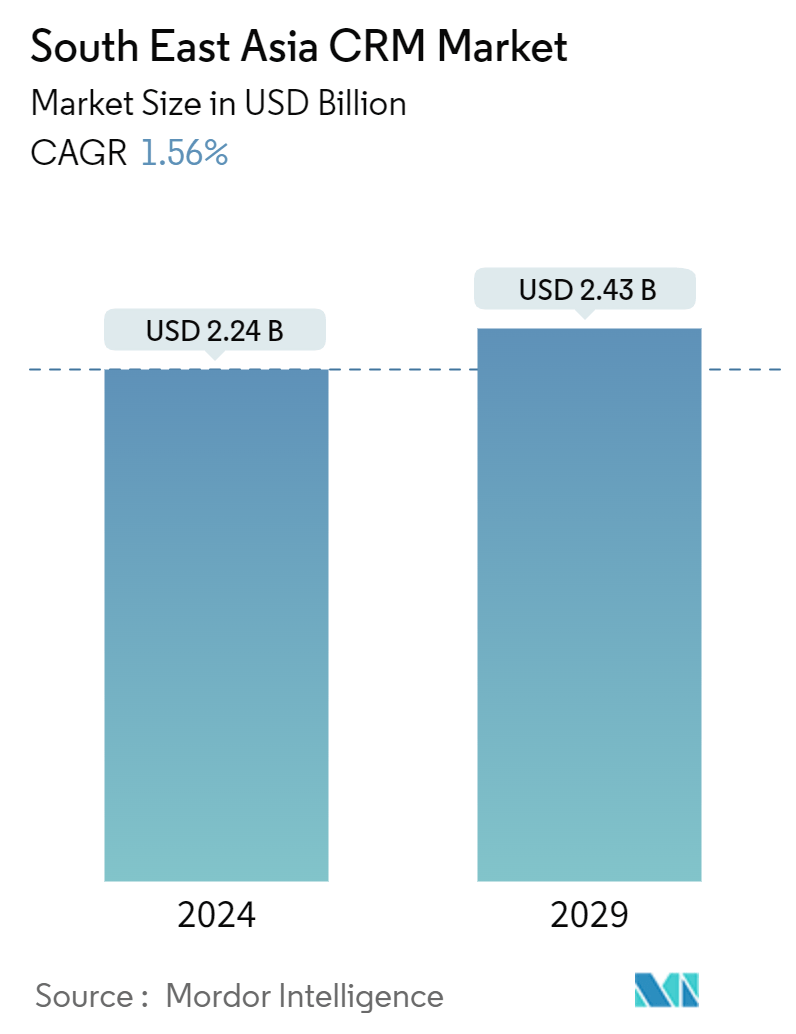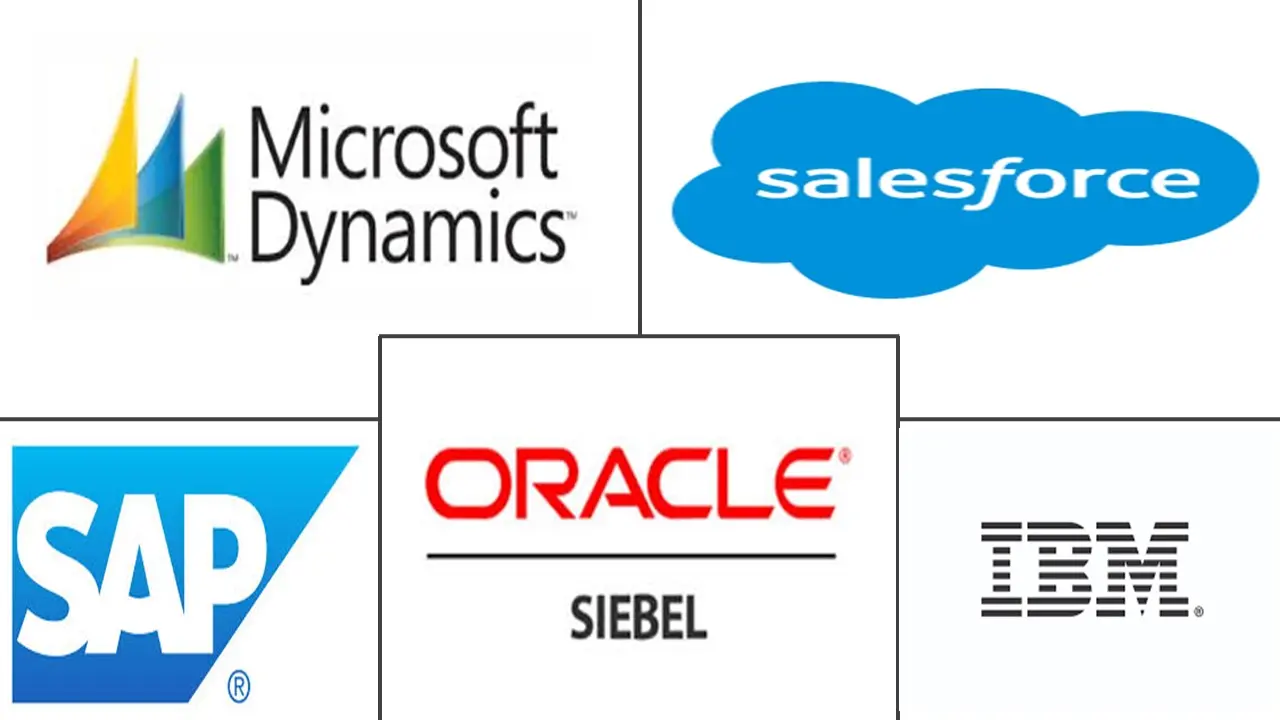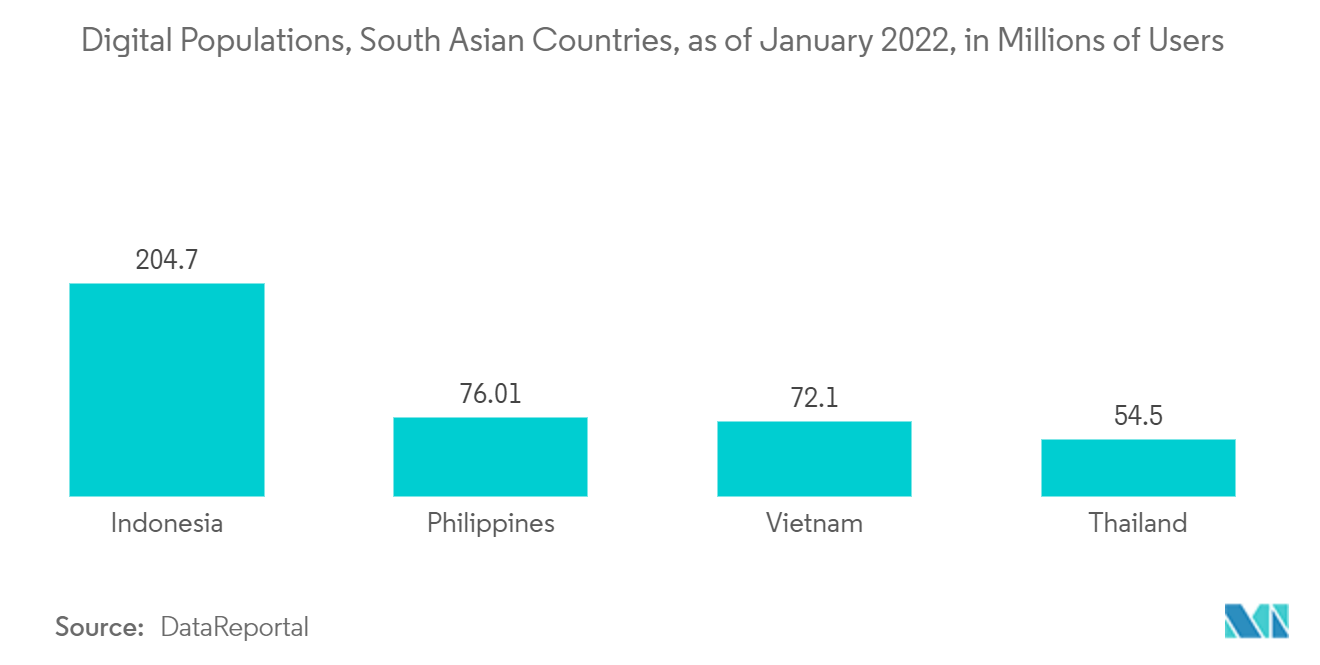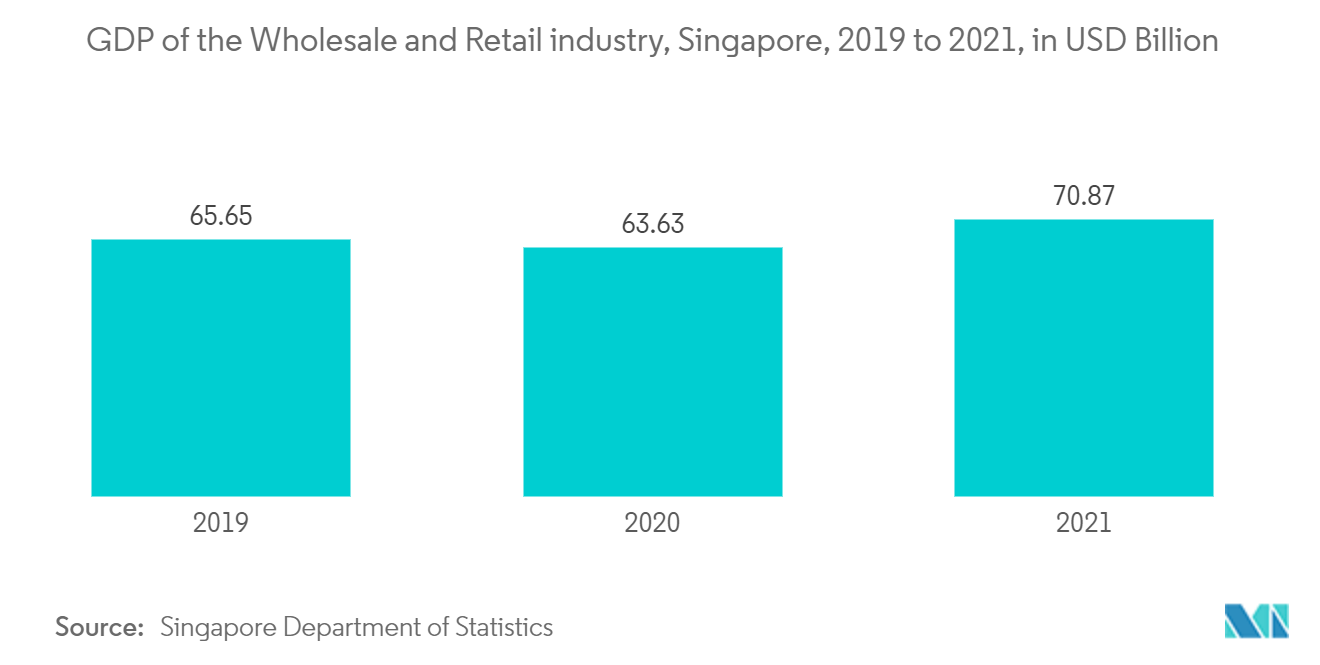South East Asia CRM Market Size

| Study Period | 2019 - 2029 |
| Base Year For Estimation | 2023 |
| Market Size (2024) | USD 2.24 Billion |
| Market Size (2029) | USD 2.43 Billion |
| CAGR (2024 - 2029) | 1.56 % |
| Market Concentration | Medium |
Major Players
*Disclaimer: Major Players sorted in no particular order |
South East Asia CRM Market Analysis
The South East Asia CRM Market size is estimated at USD 2.24 billion in 2024, and is expected to reach USD 2.43 billion by 2029, growing at a CAGR of 1.56% during the forecast period (2024-2029).
Mature customer service, automated engagement, improved customer experience, and increasing scope of digital operations are a few factors fueling the demand for CRM solutions across various industry verticals in the region.
- Moreover, the development of cloud computing technology and the availability of various service models, such as SaaS, Platform as a Service (PaaS), and Infrastructure as a Service (IaaS), are also expected to drive market growth during the forecast period in the region.
- Southeast Asia has witnessed an uptake in midmarket and enterprise companies moving to more modern business software applications to enhance their business processes and enrich the customer experience. E-commerce, ERP, and Customer Relationship Management (CRM) applications have all been at the forefront of this software technology adoption.
- Furthermore, the increasing emphasis on customer engagement among enterprises and growing adoption from SMEs aided by flexible pricing strategies provided by the vendors are driving market growth in the region.
- According to the CRM Cloud Survey Report by SoftClouds (a vendor in technology solutions and digital transformation), 82% of companies use CRM solutions for sales process automation and sales reporting. According to Salesforce, CRM software helps to increase employee productivity, enhance customer engagement and retention, and reap other business benefits. According to Cloudswave, using CRM in sales can increase the number of purchases customers make with the company. These facts are likely to boost the market growth in the region.
South East Asia CRM Market Trends
Global Cues, such as BYOD, and Use of IT tools for Driving Decision Making Expected to Provide Ample Scope for Future Growth
- IT tools, such as Big Data technology for decision-making, are poised to integrate with CRM significantly in the future. Customer service is one of the most critical areas in which organizations should deliver metrics in today's landscape. Enterprises in the region have been using real-time data to provide one-on-one personalized services and solutions to their customers.
- CRM involves data, but most of it is structured, such as the latest contacts, contact information, products bought, etc. With the integration of IT tools, such as Big Data techniques, it is also possible to process, store, and analyze massive amounts of unstructured data not supplied by the customer and use this to gain additional insights. Using Big Data technologies, CRM could become a significant revenue driver.
- According to SAS, most Indonesian companies are at the awareness stage and are starting to adopt Big Data and AI technology to differentiate themselves from their competitors. The outbreak of COVID-19 significantly increased the cloud's adoption. For example, since going cloud native with GoCloud, banking and business solutions provider NewGens Pte Ltd has developed new products and gained access to new customers.
- Also, Scion, an IT business consulting specialist for clients such as Komodo Motors, Hyundai Motor Company, Maserati, Ferrari Automotive Dealerships, and the Four Seasons Hotel, shares its journey and experience on GoCloud with Amazon Web Services.
- The aforementioned factors are expected to provide growth opportunities for cloud CRM in the region. Cloud-based CRM allows robust integration with vital business applications through pre-built application connectors. This, in turn, facilitates significant user adoption of CRM. It also provides smooth data transmission to and from other business systems, reducing the requirement for intensive IT support and involvement.

Retail and Logistics Industry to Drive the Market
- To capitalize on the growing smartphone usage, new regional players have adopted e-commerce business models.So, there have been a lot of chances for vendors in the market to get more customers.
- Additionally, retailers have taken a hands-on approach to customer data to predict patterns and customer preferences and derive insights when combined with other data assets. Therefore, these companies have been integrating consumer insight with location data (GIS) to discover new insights into where and how people shop.
- Furthermore, omnichannel retailers have been at the forefront of developing customer segmentations into core shopper profiles to cater to where and how each segment behaves.
- In partnership with Singapore-based Capillary Technologies, Bata, a consumer goods retailer, strengthened its omnichannel CRM strategies across the Philippines and Vietnam. Post-deployment, the company achieved 2.2x higher returns from targeted campaigns in Singapore and 57x ROI from Facebook-based campaigns in Malaysia. To name a few, Bata used Capillary's insights and engaged platform to leverage unified campaigns and precise custom targeting.
According to a joint survey conducted by Centaur Media plc and Resulticks, the ability to deliver content and messages in real-time and across multiple channels directly impacted the efficiency and effectiveness of customer engagement. Most Southeast Asian businesses use real-time marketing and omnichannel delivery and engagement to meet their short-term marketing goals. Real-time marketing is chosen by 65% of businesses, while omnichannel delivery and engagement is chosen by 52%.

South East Asia CRM Industry Overview
The Southeast Asia CRM analytics market is competitive and consists of global and local players. These companies leverage product enhancements and partnership initiatives to strengthen their market share and increase profitability. Some of the key developments in the market are:
In July 2022, Oracle Fusion Sales, developed by Oracle, is the next-generation sales automation program that discovers high-quality sales prospects and encourages dealers to complete transactions more quickly. Fusion Sales, part of Oracle Fusion Cloud Customer Experience (CX) and driven by artificial intelligence (AI), automatically offers sellers proposals, quotations, and recommended steps to enhance productivity, complete more deals, and build confidence among customers.
South East Asia CRM Market Leaders
-
Salesforce.com Inc.
-
Microsoft Dynamics
-
Oracle Siebel
-
SAP SE
-
IBM Corporation
*Disclaimer: Major Players sorted in no particular order

South East Asia CRM Market News
- September 2022 : Capgemini acquired Singapore-based Aodigy to expand its Salesforce expertise. The acquisition of the Singapore-based specialized partner is intended to boost Capgemini's regional capabilities to provide "end-to-end digital transformation at scale." Access to Aodigy's entire suite of Salesforce ecosystem customer engagement products, including cloud migration, customer interaction, sales optimization, and business process automation, would be central to such efforts, with offices in Singapore and Vietnam.
- June 2022: Microsoft Viva Sales, a new seller experience application, was launched by Microsoft Corp. This, Viva Sales combines any CRM system with customer engagement data from Microsoft 365 and Microsoft Teams and uses AI to deliver customized suggestions and insights to help sellers in connecting with their customers more effectively. This enables sellers to customize their client interactions more effortlessly and efficiently.
South East Asia CRM Market Report - Table of Contents
1. INTRODUCTION
- 1.1 Study Assumptions and Market Definition
- 1.2 Scope of the Study
2. RESEARCH METHODOLOGY
3. EXECUTIVE SUMMARY
4. MARKET DYNAMICS
- 4.1 Market Overview
-
4.2 Industry Attractiveness - Porter's Five Forces Analysis
- 4.2.1 Bargaining Power of Suppliers
- 4.2.2 Bargaining Power of Buyers
- 4.2.3 Threat of New Entrants
- 4.2.4 Threat of Substitute Products
- 4.2.5 Intensity of Competitive Rivalry
-
4.3 Market Drivers
- 4.3.1 Global Cues, such as BYOD, and Use of IT tools for Driving Decision Making Expected to Provide Ample Scope for Future Growth
- 4.3.2 Emergence of Several Pure-Play CRM Solutions at a Local and Regional-Level, to Compete with the Top 5 incumbents
- 4.3.3 Increasing Adoption from SME's Aided by Flexible Pricing Strategies Provided by the Vendors
-
4.4 Market Challenges
- 4.4.1 Operational and Implementational Challenges
- 4.4.2 Cost and Lack of Resources and Skilled Professionals
- 4.5 Analysis of the Global CRM Landscape
- 4.6 Assessment of Impact of Covid-19 on the South East Asia CRM Market (Customers & Prospective buyers opting for digital channels| Growing need for SME's to utilize digital tools to engage with their target audience| Short & Medium-term trend analysis)
- 4.7 Key Segments in the CRM Industry - Contact Center, Customer Service, Sales Automation, and Marketing Automation
- 4.8 Key Considerations Involved in the Selection of a CRM tool in the SEA region
5. MARKET SEGMENTATION
-
5.1 By Organization Size
- 5.1.1 Small and Medium
- 5.1.2 Large Scale
-
5.2 By Deployment Size
- 5.2.1 Cloud
- 5.2.2 On-premise
- 5.2.3 Hybrid
-
5.3 By End-user Vertical
- 5.3.1 Services
- 5.3.2 Manufacturing
- 5.3.3 BFSI
- 5.3.4 Retail and Logistics
- 5.3.5 Government
- 5.3.6 Other End-user Verticals (Construction, Not for Profits, Education, Energy & Utilities, etc.)
-
5.4 By Country
- 5.4.1 Indonesia
- 5.4.2 Singapore
- 5.4.3 Philippines
- 5.4.4 Thailand
- 5.4.5 Malaysia
- 5.4.6 Rest of South East Asia
6. ANALYSIS OF KEY CRM SOLUTION VENDORS IN SEA (GLOBAL AND REGIONAL - BASED ON THEIR CURRENT FOOTPRINT)
7. COMPETITIVE INTELLIGENCE
-
7.1 Company Profiles
- 7.1.1 Salesforce.com Inc.
- 7.1.2 Microsoft Dynamics
- 7.1.3 Oracle Siebel
- 7.1.4 SAP SE
- 7.1.5 Hubspot Asia Pte Ltd
- 7.1.6 IBM Corporation
- 7.1.7 Zoho Corporation
- 7.1.8 Barantum (PT Kosada Group)
- 7.1.9 Capillary Technologies
- 7.1.10 Infusion Software Inc.
- 7.1.11 SugarCRM Inc.
- 7.1.12 Qontak Pte Ltd
- 7.1.13 Deskera Holdings Ltd
- 7.1.14 Soft Solvers Solutions Sdn Bhd
- 7.1.15 Tigernix Pte Ltd
- 7.1.16 Vinno Software Company
- 7.1.17 Creatio
- 7.1.18 Sage Group PLC
- 7.1.19 Insightly Inc.
- 7.1.20 PT VADS Indonesia
- *List Not Exhaustive
8. INVESTMENT ANALYSIS
9. FUTURE OUTLOOK
** Subject To AvailablitySouth East Asia CRM Industry Segmentation
The Customer Relationship Management (CRM) Software market is a subsegment of the Enterprise Software market geared toward managing external business contacts and communication in marketing, sales, and acquisition. It offers standalone software designed to help end-user companies manage a customer's entire life cycle, including marketing, sales, customer services, and contact center. The market estimations consider CRM software applications (license/subscription) in Sales, Marketing, Contact centers, and Customer Services. In contrast, CRM Analytics and other custom applications of CRM Software are excluded from the study scope as these are offered as an enhanced capability based on requirement and charged for customization that is not tracked owing to feasibility factors.
The Southeast Asian CRM market is segmented by organization size (small and medium and large scale), deployment size (cloud, on-premise, and hybrid), end-user vertical (services, manufacturing, BFSI, retail and logistics, government), and country (Indonesia, Singapore, Philippines, Thailand, Malaysia, Rest of South East Asia)
The market sizes and forecasts are provided in terms of value (in USD) for all the above segments.
| By Organization Size | Small and Medium |
| Large Scale | |
| By Deployment Size | Cloud |
| On-premise | |
| Hybrid | |
| By End-user Vertical | Services |
| Manufacturing | |
| BFSI | |
| Retail and Logistics | |
| Government | |
| Other End-user Verticals (Construction, Not for Profits, Education, Energy & Utilities, etc.) | |
| By Country | Indonesia |
| Singapore | |
| Philippines | |
| Thailand | |
| Malaysia | |
| Rest of South East Asia |
South East Asia CRM Market Research FAQs
How big is the South East Asia CRM Market?
The South East Asia CRM Market size is expected to reach USD 2.24 billion in 2024 and grow at a CAGR of 1.56% to reach USD 2.43 billion by 2029.
What is the current South East Asia CRM Market size?
In 2024, the South East Asia CRM Market size is expected to reach USD 2.24 billion.
Who are the key players in South East Asia CRM Market?
Salesforce.com Inc., Microsoft Dynamics, Oracle Siebel, SAP SE and IBM Corporation are the major companies operating in the South East Asia CRM Market.
What years does this South East Asia CRM Market cover, and what was the market size in 2023?
In 2023, the South East Asia CRM Market size was estimated at USD 2.21 billion. The report covers the South East Asia CRM Market historical market size for years: 2019, 2020, 2021, 2022 and 2023. The report also forecasts the South East Asia CRM Market size for years: 2024, 2025, 2026, 2027, 2028 and 2029.
South East Asia CRM Industry Report
Statistics for the 2024 South East Asia CRM market share, size and revenue growth rate, created by Mordor Intelligence™ Industry Reports. South East Asia CRM analysis includes a market forecast outlook to 2029 and historical overview. Get a sample of this industry analysis as a free report PDF download.



